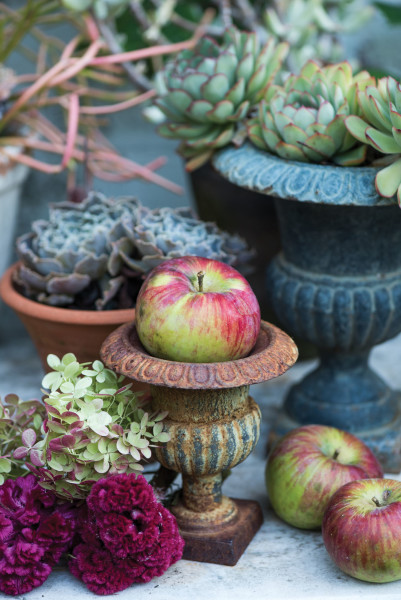
Echeverias are in the mini urns beside a harvest of dried flowers and local apples.
Kindra Clineff
Fall is the fastest moving season. Early September often looks a lot like summer, but the whole scene begins to blush and blaze just a few weeks later. One day your spirea is a washed-out green, the next day it turns toward coppery red. It’s on fire for a week—and then the foliage strips itself overnight, leaving the skeleton of a naked shrub. If you fail to keep your eyes open, you’ll miss a riveting pageant.
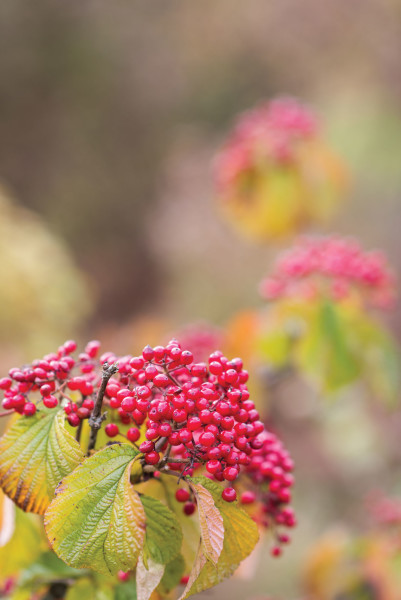
The red berries of Viburnum dilatatum ‘Cardinal Candy’ are food for birds.
Kindra Clineff
Often referred to as “the forgotten season,” autumn is written off by some gardeners simply because it eventually slips into winter. But autumn is highlighted on the calendar at Furthermore, the name I’ve given my garden in Litchfield County, Connecticut. My house is an early 19th-century cobbler’s shop attached to a barn, all since converted to a residence. To match the era, I have planted a cottage garden with plant-filled beds stretching to the main street in my tiny New England town. A constant parade of joggers, cyclists, dog walkers, and drivers in their cars whiz or stroll by every day. For their pleasure as well as for my own amusement, I extend the season as long as possible. By filling the space with an arsenal of late-blooming perennials, shrubs, and ornamental grasses, the perks continue long after first frost.
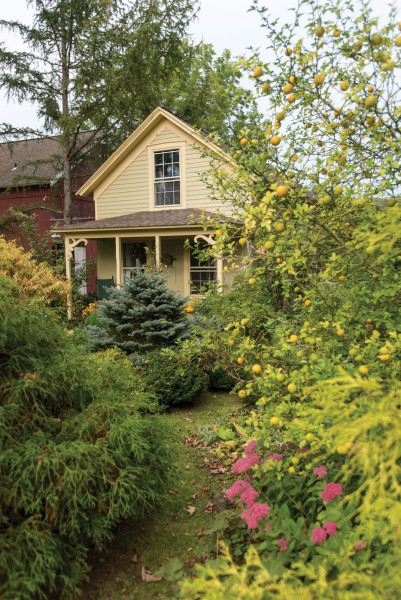
Tovah Martin’s Connecticut home is a former early-19th-century cobbler’s shop and barn.
Kindra Clineff
Autumn can be thrilling. Even sedate gardens may slip into raging hues as rudbeckias, echinaceas, and mums burst into radiant shades of color that merge with the backdrop of changing tree foliage. Asters need not be relegated solely to the fields. Although some might be gangly, I work with periwinkle-blue Symphyotrichum (so sorry, but that’s what they have renamed asters) oblongifolium ‘Raydon’s Favorite’ and ‘October Skies’ to complement the orange and yellow of nearby trees. Rather than planting typical annual mums, searching out reliably perennial types with longer stems and looser growth feels simpatico with a vintage setting. Plant Dendranthema (yep, that’s what they’ve renamed hardy chrysanthemums) ‘Sheffield’, with champagne-colored blossoms, or ‘Cambodian Queen’ in porcelain pink to keep late-visiting pollinators productive.
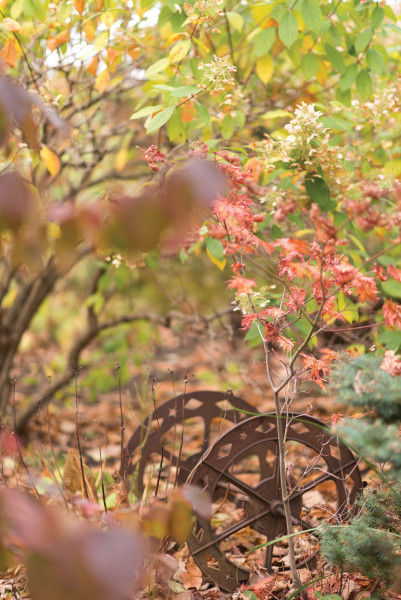
Industrial wheels become ornaments beside a Japanese maple.
Kindra Clineff
Autumn is when the milkweeds so important for monarchs are at prime. Most milkweeds are best left in the meadow, but bright orange Asclepias tuberosa and pink Asclepias incarnata are perfectly well behaved in the garden. But autumn standbys are not our only options. My extra effort to cut back nepeta (catmint), salvia, delphiniums, and other spring and early-summer performers after bloom is often rewarded with a repeat flowering in autumn. The late show won’t be as fervent as the first go-around, but any second second show of color is doubly appreciated.
Colorful foliage is part of fall’s pageant. You can reverberate off surrounding tree foliage by planting perennials and shrubs with autumn interest. Because I want to share the glory with the community, I planted a blue star (Amsonia hubrichtii) along the highly visible road. Not only does its feathery foliage tolerate the turbulence on the street, but it also turns bright orange and then flaxen blond deeper into autumn. Several large Amsonia tabernaemontana plants repeat the peachy color along the border. The repetition trick proves particularly effective in fall, when color abounds. Rather than displaying a dizzying array, use color echoes or repeats at regular intervals as visual touchstones. Sedums, too, are appropriate for the job, but I’ll even resort to flowering cabbages and ornamental kales for syncopation.
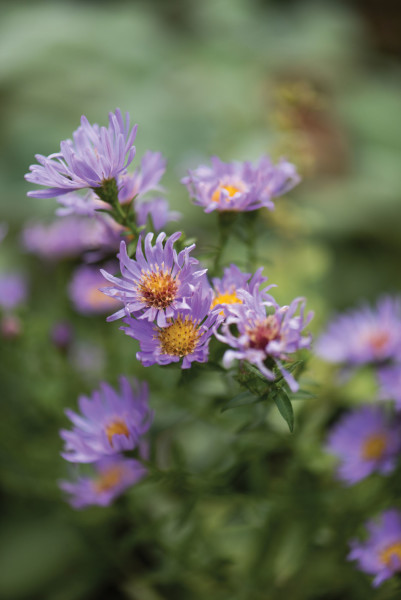
Symphyotrichum oblongifolium ‘Raydon’s Favorite’ is a wild aster bred as a radiant blue garden plant.
Kindra Clineff
Gardeners with finite space focus on shrubs that work hard for as long as possible: you might want to invite some viburnums into your domain. Many boast autumn color and several have berries as well. In some cases, the birds rapidly strip the harvest—but feeding feathered friends has its own rewards. Blueberries are usually finished producing fruit by autumn, but their foliage features spectacular orange hues. Hydrangeas hold their blossoms in a faded state until winter, and then the flower umbels dry to flaxen to entertain until tidying-up time in spring. Enkianthus has adorable dangling flowers in spring, but also raging orange leaves in fall. Witch hazel looks like it’s on fire in fall, ahead of late-fall and midwinter blossoms after the foliage drops.
Furnish your garden with fall features and the landscape will serve all creatures great and small. Granted, I’ve worked at upping the autumn game—and so my garden’s glory is extended.
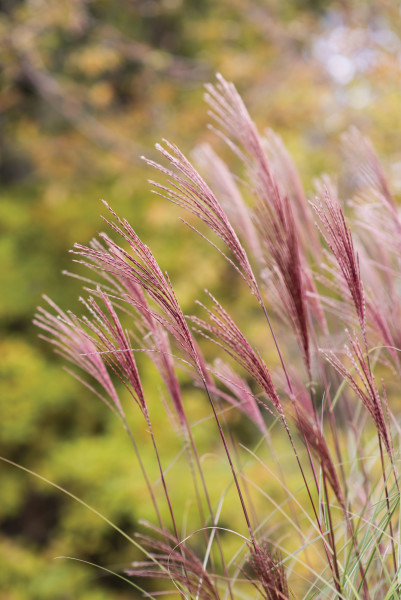
Miscanthus sinensis ‘Morning Light’ sends up plumes in late summer, which blanch flaxen in late autumn.
Kindra Clineff
Ornamental Grasses
Autumn is associated with ornamental grasses. Their plumes add subtle, smoky tufts to the garden and give it a field-like textural component. Reminiscent of the nubby sweaters donned now, grasses give depth to the late-season garden. Martin’s personal favorite is the variegated maiden grass (Miscanthus sinensis ‘Morning Light’) with its bleached white blades. With frost, those blades curl, as do the plumes standing above. They can hold through winter in a blanched state, but she rushes out to cut them down before the first snowstorm. (Easily dislodged, the plumes would be sent scattering hither and yon by snow plows, never popular with the neighbors.) Also riveting are the rabbit tail-like tufts on top of fountain grasses—especially Pennisetum alopecuroides ‘Little Bunny’.
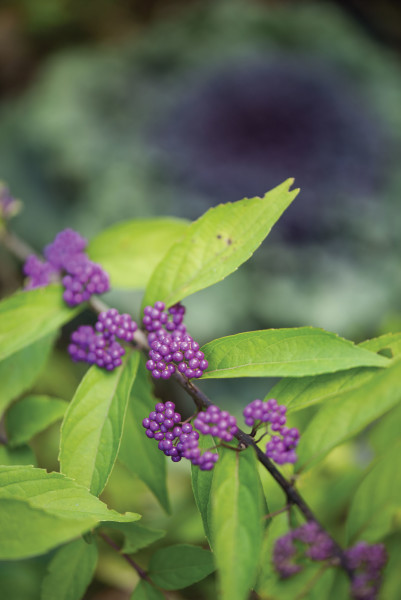
Beautyberry’s lavender fruit remains on branches even after the leaves drop.
Kindra Clineff
Berries are a major perk of autumn. Beyond the viburnums, the beautyberry—Callicarpa spp.—produces glistening, lavender-color berries that cling through the winter and provide birds with a last-resort meal during frigid weather. In addition to being head-turning sparks of color in the late season landscape, winterberries (Ilex verticillata) can provide hungry birds with a feast after the berries have frozen and thawed repeatedly. Although the orange versions are glorious, they aren’t as popular with birds as are the original red, the author says.
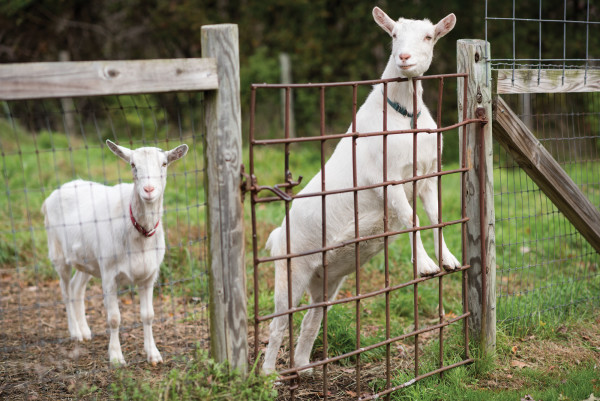
Saanen goats Sweetpea (perched on a custom-made gate) and Violet graze a pasture, control poison ivy, furnish fertilizer, and serve as the gardener’s BFFs.







